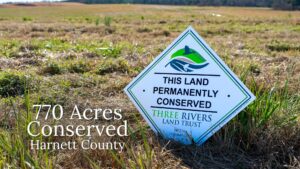
By: Crystal Cockman
Steve Hall, invertebrate zoologist, recently conducted a landscape survey in the Uwharries, with a main focus on insects. This was part of a joint effort by the NC Natural Heritage Program and the NC Wildlife Resources Commission in 2010 and 2011.

Insects are small organisms but key in determining the overall health of the larger ecosystem. Because a large number of them are habitat specialists and need to be able to move between habitat patches fairly frequently, their presence is indicative not only of individual high quality habitats but also of a larger high quality habitat system.
Steve’s study focused on three particular insect groups – Lepidoptera (moths and butteflies), Orthoptera (grasshoppers and crickets), and Odonata (dragonflies and damselflies). The LandTrust was fortunate to have Steve visit a number of our preserves while conducting this survey.

Steve found several rare and watch list species at our Low Water Bridge Preserve in Montgomery County. This included three dragonflies, Septima’s clubtail (Gonphus septima), Piedmont clubtail (Gonphus dilatatus), and Blackwater clubtail (Gomphus parvidens). In the wet hardwood forest on the site, Steve found a moth that is a new genus, Notodontid New Genus 1. He also found a rare species of moth associated with the canebrake ecosystem on our Low Water Bridge Preserve (Protampamea danieli).
The Calico Pennant dragonfly (a common species) was found on our Capel Property, recently transferred to the NC Wildlife Resources Commission, also in Montgomery County. Steve found a really rare moth, Bleptina sangamonia, on both our Little Long Mountain property, and the King Mountain property we transferred to the US Forest Service in 2012, located in Randolph County.

The LandTrust’s efforts to preserve key lands linking Uwharrie National Forest lands benefit not only recreation efforts, such as the Uwharrie Trail reconnection, but also provide important wildlife corridors for species large and small, from black bear and bobwhite quail to moths and grasshoppers.
These insect species pollinate crops that supply us with fresh produce and seeds that disperse wildflowers and regrow forests, and are food for fish that we can enjoy as both sport in fishing for and food, and provide a whole host of other ecosystem services that generally help hold the world together. As John Muir said, “When we try to pick out anything by itself, we find it hitched to everything else in the Universe.” On Earth day and every day, we should remember the importance of preserving the uniqueness of the world around us, both now and for future generations.